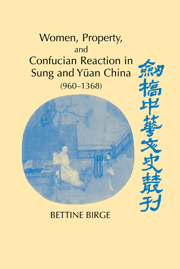Book contents
- Frontmatter
- Contents
- List of Maps, Figures, and Tables
- Chronology of Chinese Dynasties
- Abbreviations
- Acknowledgments
- Introduction
- 1 Women and Property before the Sung: Evolution and Continuity
- 2 Women and Property in the Sung: Legal Innovation in Changing Times
- 3 Women's Property and Confucian Reaction in the Sung
- 4 Transformation of Marriage and Property Law in the Yüan
- Conclusion: Gender, Mongols, and Confucian Ideals
- Bibliography
- Glossary-Index
Conclusion: Gender, Mongols, and Confucian Ideals
Published online by Cambridge University Press: 24 August 2009
- Frontmatter
- Contents
- List of Maps, Figures, and Tables
- Chronology of Chinese Dynasties
- Abbreviations
- Acknowledgments
- Introduction
- 1 Women and Property before the Sung: Evolution and Continuity
- 2 Women and Property in the Sung: Legal Innovation in Changing Times
- 3 Women's Property and Confucian Reaction in the Sung
- 4 Transformation of Marriage and Property Law in the Yüan
- Conclusion: Gender, Mongols, and Confucian Ideals
- Bibliography
- Glossary-Index
Summary
In any society, the construction of gender is a continuous process intimately connected to other historical developments such as in society, government, and foreign relations. The case of women and property in Sung and Yüan China provides an excellent example of these connections. The Mongol invasion together with longer-term historical changes over the Sung and Yüan created a new constellation of property and gender relations in China that brought them closer to patrilineal ideals as defined by Learning of the Way Confucians of the Sung.
Patriline principles were part of Chinese society from earliest times, as seen in Confucian ritual texts, legal codes, and popular practices such as agnatic ancestor worship. Nevertheless, the institutionalization of patrilineality in China was never complete, and especially in the area of property relations severe tensions existed between Confucian ideals, state law, and social practice.
Formal law and Confucian rhetoric tied the transmission of property to the male patriline and accompanying ancestral sacrifices. From at least the Han dynasty, Confucian ritual prescriptions that favored only one descent-line heir had been reinterpreted in the light of popular practices to dictate that every son in a family produce an unending line of male descendants, who could perform ancestral sacrifices in perpetuity.
- Type
- Chapter
- Information
- Publisher: Cambridge University PressPrint publication year: 2002

